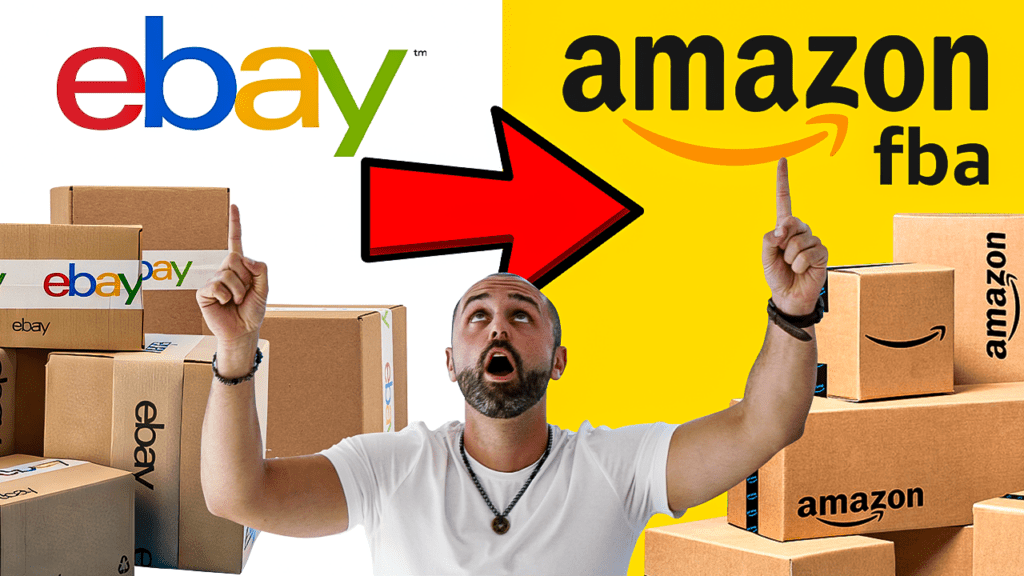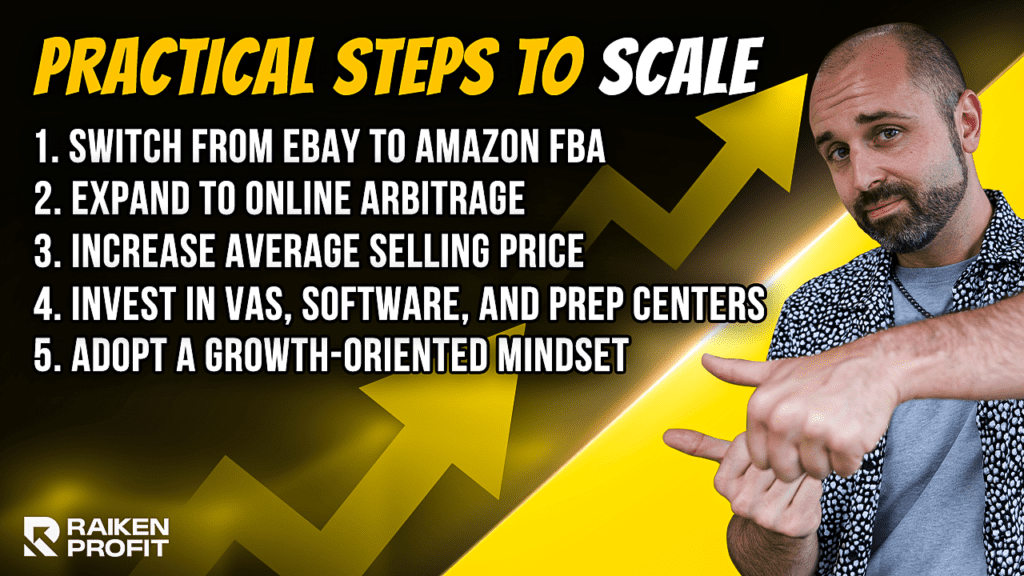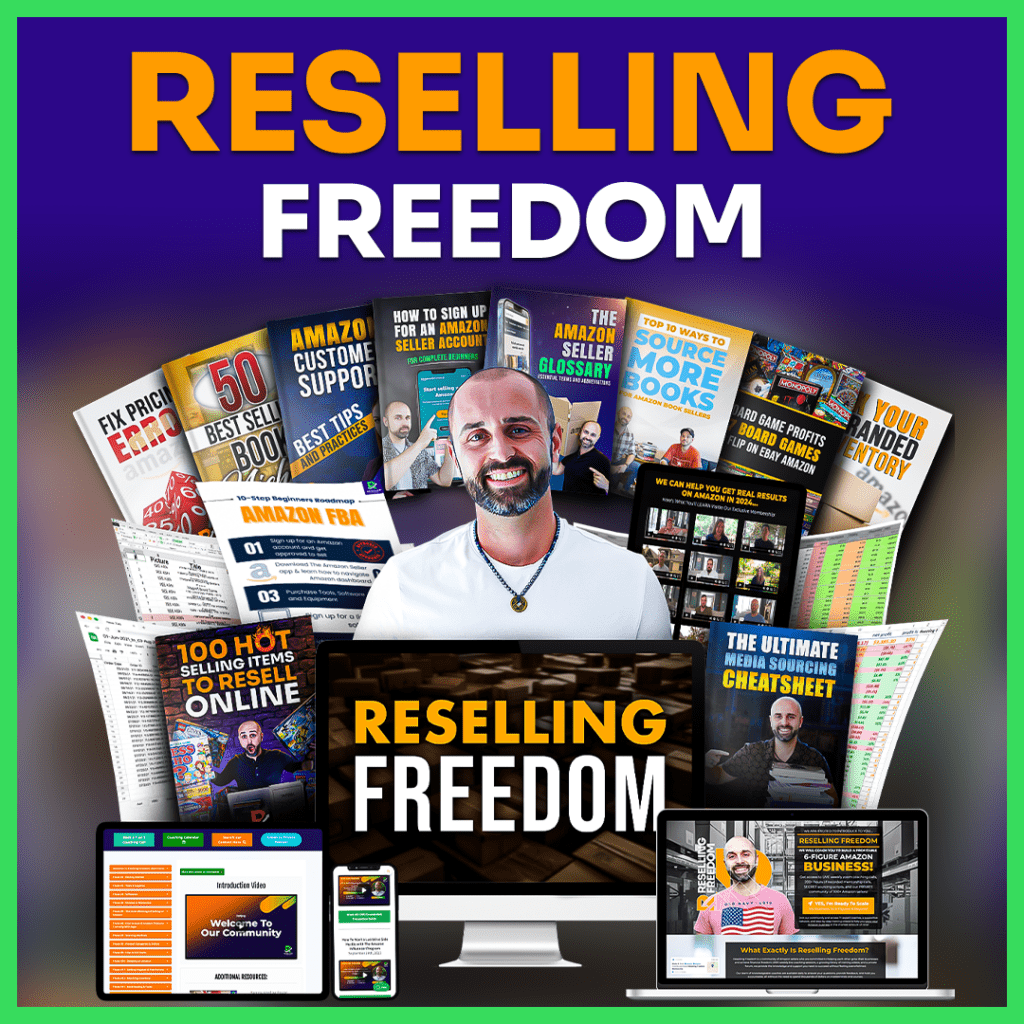
Building a profitable Amazon business is no easy feat, and many new sellers quit before they even get their first sale.
If you’re one of the few who’s already making a few thousand dollars per month—congrats! That’s something to be proud of.
But what if you want to scale beyond that, hitting monthly revenues of $10K, $20K, or even $50K?
It requires more than just ambition; it demands strategic changes in your approach, mindset, and systems.
Here’s a comprehensive guide on the mindset shifts, business model changes, and practical strategies that can take your Amazon business to the next level, with advice drawn from personal experience and industry insights.
1. Transition from eBay to Amazon FBA: Buy Back Your Time

If you’ve been selling on eBay, you know it’s a hands-on operation.
You’re managing listings, handling shipping, and storing inventory, which can quickly turn into a time sink.
For those looking to scale, time becomes a limiting factor.
Transitioning from eBay to Amazon FBA (Fulfillment by Amazon) can alleviate these bottlenecks and open doors to higher sales volumes.
Why Switch to Amazon FBA?
Reduced Time on Logistics: Amazon handles the packing, shipping, and customer service, freeing up your time to focus on sourcing.
Increased Reach and Sales Potential: Products listed on Amazon often reach a wider audience, and with Prime-eligible listings, you can offer faster shipping.
Higher Selling Prices: While Amazon has higher fees, the platform allows you to charge more due to its vast customer base.
Here’s a quick comparison of eBay vs. Amazon FBA:

Switching to Amazon FBA might initially feel costly, but the return in time and revenue potential can far outweigh those fees, especially when scaling.
2. Embrace Online Arbitrage for Scalable Sourcing

When sourcing from local thrift stores, flea markets, and garage sales, you’re limited by what you can physically access.
Scaling to a higher revenue requires broadening your sourcing methods, and online arbitrage is a highly effective approach.
What is Online Arbitrage?
Online arbitrage (OA) involves purchasing items from online retailers like Walmart, Target, or eBay at a discount and reselling them on Amazon at a markup.
With OA, you’re no longer limited by geography or available hours in a day; the inventory comes to you.
How to Succeed with Online Arbitrage
Use Cashback and Deal Sites: Sites like Rakuten offer cashback on online purchases, which can increase your margins. There are also deal-finding tools like Honey that alert you to discounts.
Consider Sourcing Platforms: Look into platforms like Tactical Arbitrage, which scans retailer sites for potential arbitrage opportunities.
Stack Coupons and Cashback: Advanced OA sellers often stack coupons and cashback offers to maximize profit, effectively “engineering” better ROI.

While OA may yield lower ROI per item than thrifted finds, it offers scalability that thrift stores can’t match.
The larger volume and consistency it allows make it ideal for growing a sustainable, larger-scale business.
3. Increase Your Average Selling Price (ASP)

Selling low-ticket items can be a time sink, especially if you’re processing dozens or hundreds of items to make a profit.
Instead, focus on raising your ASP to get more profit from fewer transactions.
It’s an approach that saves time and boosts your margins.
How to Raise Your ASP
Set a Minimum Profit Goal: Avoid items that don’t meet a certain profit threshold. If you aim for at least $10 profit per item, you can filter out low-value inventory.
Focus on High-Value Categories: Categories like electronics, kitchen appliances, and tools typically offer higher ASPs and profits.
Leverage Amazon’s Professional Tools: Tools like Keepa and SellerAmp can help you monitor the price history and demand of products to identify items with higher ASP potential.

By raising your ASP, you’re working smarter, not harder.
This strategy ensures that each sale is worth your time, helping you hit profit targets without endless hours listing and shipping.
4. Leverage Virtual Assistants, Software, and Prep Centers

Growing an Amazon business can feel like managing a mini corporation.
With so many moving parts, from sourcing to listing and customer service, it’s essential to offload tasks through automation and delegation.
Tools and Strategies to Scale Efficiently
Virtual Assistants (VAs): Hiring VAs can relieve you of sourcing, customer service, and admin tasks. You can find skilled VAs on platforms like Upwork or OnlineJobs.ph.
Repricing Software: Tools like RepricerExpress help keep your prices competitive, increasing your sales velocity.
Prep Centers: Using prep centers allows you to outsource packaging and shipping. They receive, inspect, label, and ship your items to Amazon, freeing you from logistics.

These resources save time, reduce physical demands, and streamline operations, which are crucial when scaling beyond $10K or $20K per month.
5. Build a Resilient Mindset and Business Model

Scaling requires mental resilience and adaptability.
As revenue grows, so do the challenges—from cash flow management to handling increased risk.
Maintaining a mindset geared toward learning, risk management, and perseverance is essential.
Mindset Shifts for Growth
Prioritize Long-Term Gains Over Short-Term Wins: Building an Amazon business that lasts means consistently reinvesting profits into better inventory, tools, and resources.
Focus on Knowledge and Skills: Learning more about inventory management, sourcing strategies, and financial planning will set you apart from those who plateau at lower revenue levels.
Cultivate a Growth Network: Surround yourself with sellers and mentors who are achieving higher revenue goals. They can offer insights and support as you face new challenges.

6. Practical Steps to Scale (A Recap)

Scaling to $50K a month isn’t about sudden changes but strategic shifts over time. Here’s a recap of actionable steps:
- Switch from eBay to Amazon FBA: Leverage FBA to save time on logistics and reach a larger audience.
- Expand to Online Arbitrage: Source products online to ensure a steady inventory flow.
- Increase Average Selling Price: Focus on high-value items to boost profits.
- Invest in VAs, Software, and Prep Centers: Delegate and automate for efficiency.
- Adopt a Growth-Oriented Mindset: Build resilience, learn continuously, and plan for the long-term.
By incorporating these steps, you’ll be on the right path to building a scalable, profitable Amazon business.
Remember, growth takes time, consistency, and sometimes tough decisions about what to leave behind to focus on what works best.
With patience and persistence, hitting that $50K monthly revenue goal is well within reach!









